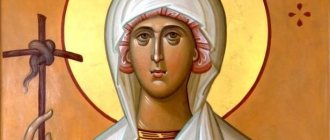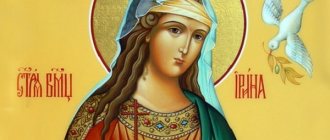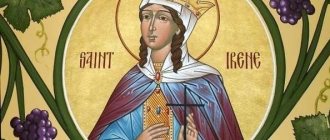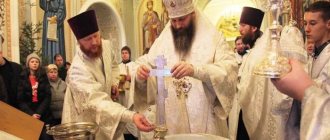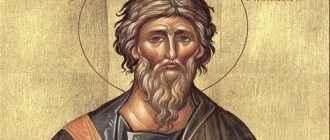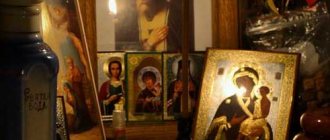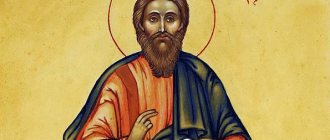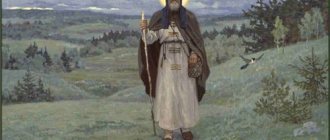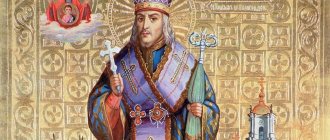Every year during Great Lent, a special service is held in all churches in memory of the great saint - Mary of Egypt, a woman who rose above the exploits of many great men. This special service with genuflection is always performed in the fifth week of Lent on Thursday morning, and in practice, usually on Wednesday evening. In common parlance this service is called “Standing of Mary”. Why is this special penitential service performed on the day of remembrance of St. Mary of Egypt?
Life
Her life tells the story of a terrible sinner, a harlot, who once repented her entire life - she devoted almost 50 years to repentance - three years for one year of sin. The Holy Fathers call the struggle against the spirit of fornication a fierce struggle. For many years Mary struggled with the fierce beasts of her thoughts in the desert.
Saint Mary of Egypt, with life, second half of the 17th century. Wood, tempera. 136 × 105 cm State Tretyakov Gallery, Moscow, Russia Inv. 29551
The Life is usually read in two sittings between the reading of the penitential canon. The story begins with an acquaintance with the monk, who told the Orthodox world about the holy Egyptian wife. A certain Zosima, a monk from his youth who lived in fasting and prayer, suddenly began to think about himself: am I not an ascetic, have I not surpassed all others in my exploits? The Lord's fatherly care for those who strive, His attention, help and punishment saved Zosima from delusion.
Interesting fact
Punishment is a lesson for salvation. Punishment in the sense of a command, instruction, lesson. It happens that God sends punishment to a person, but the person confuses punishment with insult or damage to himself. Because punishment is often accompanied by the taking away of the means of sin.
The love of God commanded Zosima to leave his monastery, from his usual conditions, familiar and, to a certain extent, comfortable, and go to an unknown monastery lost in the desert, which had a strict charter and one pious custom. On Holy Pentecost, all the inhabitants left the monastery for the desert and there, throughout Lent, they searched for spiritual fruits one by one.
Venerable Mary of Egypt Last quarter of the 18th century. Wood, oil. 20 × 15.5 cm Private collection
The Lord saved Zosima from destructive vain thoughts about his exploits when he met a naked man, burned by the sun, in the desert, who turned out to be a woman. She asked the monk to throw her some clothes to cover herself, and then she told him about her life.
Useful materials
John Chrysostom says this about the sinful harlot:
“A crazy sight: a harlot wife in the city is <like> a war within the walls... she is a lure of young men, a touchstone of desire, an awakening of passion, profiteering in the body, useless trade, a harmful enterprise that brings death to the seller and the buyer, a network of youth that is not hidden trap. The eyes of a harlot are a snare for sinners; <she> is a pledge of debauchery, a self-seller who enslaves buyers, a many-headed lioness, the stench of the city, an ulcer that spreads through all the senses, a fishing rod for the eyes, a circular death, a market of loss, the passion of destruction, the smell of death, a multi-purulent wound... This is the ulcer of the inhabitants, the rapist of marriage , loss of honor, struggle between husbands and wives, a meal that requires bad expenses, emptying of wallets, waste of property, loss of labor...”
The wife, who met Zosima and told him about her fate, called herself in the worst words: “the chosen vessel of the devil,” “earth and ashes.” She did not tell him her name, but told him in every detail, without hiding anything, about her former life, poisoned by sin. Repentance had already led the blessed soul to dispassion, which is why the story was detailed.
Venerable Mary of Egypt, with her life. End of the 19th century. Wood, tempera. 31 × 26.5 cm Vladimir-Suzdal Historical, Artistic and Architectural Museum-Reserve, Vladimir, Russia Inv. B-17382
At the age of twelve, having lost her innocence, she threw herself headlong into the pool of fornication and bathed there with pleasure. Nothing could stop her in this sin, not for money she gave herself to everyone who wanted, but out of love for sin. And even the one who didn’t want to was seduced against his will by her, being an Egyptian beauty with black curls, sparkling eyes and a white-toothed smile. So seventeen years passed.
But one day... “Blessed is God, who cares for the salvation of people and souls,” she found herself in Jerusalem in front of the doors of the temple. It was on the day of the Exaltation of the Holy Cross. Then a miracle happened: the conscience, drowned in sin, was resurrected. Everyone came to the temple for the holiday, but a certain force did not allow the sinner to cross the threshold. No matter how many times I tried, nothing worked.
“The word of salvation touched the eyes of my heart, showing me that the uncleanness of my deeds was blocking my entrance. I began to cry and mourn, beating myself on the chest and groaning from the depths of my heart,”
- she told Zosima.
She began to beg the Most Pure Mother in front of Her icon for forgiveness and heard a voice from above: “If you cross the Jordan, you will find glorious rest.”
Having heard God's call, and without doubting for a second, she set off. Someone gave her, disheveled and tear-stained, three loaves of bread. Arriving on the shore of the Jordan, there, in the Church of John the Baptist, she took communion, ate some bread, washed down with river water, and, after spending the night on the shore, in the morning she set off on someone’s boat into the desert beyond the Jordan.
Saint Mary of Egypt with a life in 16 stamps Bogatyrev Ivan Vasilievich School or art. center: Nevyansk 1804 Wood, mortise through and end pins. Gesso, tempera, gilding. 62 × 53 × 3 cm State Museum of the History of Religion, St. Petersburg, Russia Inv. B-7355-IV
In this desert, having once made a vow to the Queen of Heaven, who looked upon her salvation, she spent 47 years, the first 17 of which she was terribly tormented by the memories of sin. Evil temptations presented her with brilliant pictures of food and drink, demonic songs and dances, all kinds of pleasures, tormented her, and then threw her to the ground, froze her in the cold of the night, fried her in the heat of the day.
“But I always fixed the eyes of my mind on my Surety, asking for help from the desert drowning in the waves. And she had Her as a helper and a recipient of repentance.”
There, in the desert, a former sinner died and a saint was born. The saving example of Saint Mary of Egypt, who resolutely and courageously overcame her sin, rejected satanic temptations once and for all, and firmly relied on faith in the Lord and the Most Pure Mother of God, Their help and support, inspires many generations of believers to take the saving path of fighting their passions.
Interesting fact
The Holy Fathers say that passion is already something more than sin, it is sinful dependence, slavery to a certain type of vice. St. John Climacus says that “passion is the name given to the very vice that has been embedded in the soul for a long time and through habit has become, as it were, a natural property of it, so that the soul already voluntarily and by itself strives towards it” (Ladder. 15: 75).
The saint amazed Zosima in the desert because, being illiterate, she quoted the Holy Scriptures. After all, as she said, having run away from her parents at the age of twelve, and then living ugly in Alexandria, she was in need, because she didn’t really have any craft in her hands or education. It’s not that she couldn’t read; she had never heard of books being read. “But the Word of God, living and active, itself teaches the knowledge of man.”
Zosima saw her rising in prayer to an elbow from the ground, walking on the waters of the Jordan like dry land. After spending almost half a century in the desert, she gained dispassion, coming into the image of the reverence of God. She saw the future, predicting that she would meet Zosima in the monastery when he returned, and that the next year she herself would come to him on the banks of the Jordan to receive the Holy Mysteries of Christ.
And so it became. A year later, he gave communion to the blessed one for the second time in her life, and she, with the words: “Now dost thou let Thy servant go in peace, O Master, according to Thy word: as my eyes have seen Thy salvation,” in tears of gratitude she again withdrew into the desert, finally punishing the elder the following year he came to the place of their first meeting. There, a year later, Zosima found the body of the saint and the inscription on the ground:
“Bury, Abba Zosima, in this place the body of the humble Mary, give the ashes to the ashes, having prayed to the Lord for me, who reposed in the Egyptian month of Farmufi, called April in Roman, on the first day, on this very night of the Passion of the Lord, after the sacrament of the Divine and Last Supper "
Interesting fact
Saint Mary reposed on the same day and hour when she received the Holy Mysteries of Christ. She took communion at the Jordan, and immediately found herself far away in the desert, where she walked for twenty days. The Lord carried her. She died in that place on the day of Communion.
“Blessed is God, who elevates mortals even with a body to the life of the disembodied” - Rev. Joseph the Hesychast.
Only after the death of Saint Mary did Zosima tell the brethren about the miraculous meeting in the desert, and how God revealed to him the Secrets of His salvation, in different ways extracting the human soul from the depths of hell, and also he himself, Zosima, was saved by the Lord from the sin of vanity about his exploits .
Mother of God “Quiet my sorrows.” Venerable Mary of Egypt Sokolov Petr Mikhailovich School or art. center: Moscow 1898 Wood, tempera. 22.1 × 11 cm (each icon); 25.1 × 25.1 (kiot) Central Museum of Ancient Russian Culture and Art named after. Andrey Rublev, Moscow, Russia Inv. KP 2365 Inscription on the lower husk on both icons: 1898 in Moscow. Written by Peter Mikh. Sokolov.
St. Isaac the Syrian says: “There is no unforgivable sin except unrepentant sin.” The Monk Andrew of Crete - monk, bishop, rhetorician, hymnographer, archpastor - was also a sinner. The saint once made an unworthy concession to a heretic emperor, who, under the pretext of preserving peace in the empire, insisted on the resumption of the Monothelite false teaching. The Monk Andrei himself experienced deep repentance and put the poetic lines of penitential songs on paper. And we read them on the day of memory of the Venerable Mary.
Dissolute life
Mary was born in the fifth century AD into a wealthy family. But when she was twelve years old, she decided to leave her father's house and went to Alexandria. The girl was pretty, and the devil easily pushed her onto a vicious path. Gradually she became completely corrupted and didn’t even take money. The harlot did not remember the number of her partners, nor their names, nor their faces.
She often went hungry and spent the night on the street because she did not have permanent housing. Thus Maria spent seventeen years. One day she saw a ship that was leaving for Jerusalem . The depraved girl boarded the ship out of pure curiosity. She didn't care where to go. She did not have money to pay for the passage, so she offered to pay with her flesh.
All the way to Jerusalem, Maria was engaged in debauchery, seducing young passengers. When they arrived at the place, all the people went to the Church of the Holy Sepulchre. There was a shrine there - the Life-giving Cross of Christ. There was a holiday - the Exaltation of the Cross, and all the people tried to venerate the shrine.
Mary went with all the believers to the temple. She knew nothing about the shrine located there. But then a miracle happened that changed her whole life. Maria wanted to go into the temple, but an unknown force pushed her out of there. She tried to do this three times, and three times she was not allowed . Then the woman realized what was happening. She had an epiphany that her sins were not allowed into the temple. She fell to the floor in front of the icon of the Mother of God in the narthex and mourned her sinful life.
Prayers
The feast day of Saint Mary of Egypt falls on March 25 and April 14 according to the new style. At this time, those Marys whose birthdays are closest to these numbers celebrate their name days.
The Great Penitential Canon is read twice a year: in the first and fifth weeks of Lent. In the first week this long service is spread over four evenings, and in the fifth week it is read simultaneously on Thursday morning. Mariino's standing cannot be missed. At this service, which is special and difficult even for those who have been in the church for many years, much less for newcomers, abundant spiritual medicine is given.
Intense labor - physical and mental stress, prostrations to the ground, the very atmosphere of a dark temple, many kneeling people, the duration of the service, hearing a miraculous story about the transformation of a person from a sinner into a saint - all this sharpens the senses, awakens the conscience, makes one somehow move from death. points of deafness to one's sins. Makes the soul tremble in fear:
“My soul, arise, why are you sleeping? The end is approaching! And then catch a saving ray of hope in the call: “... and imashi will be embarrassed. Rise up, may Christ God, who is everywhere and fulfills all things, have mercy on you.”…
And then - with great fear of God, with trepidation and gratitude, expect the Bright Resurrection. The daily liturgical cycle in the church begins in the evening, therefore Thursday morning in the church is Wednesday evening, i.e. the day before.
Interesting fact
About the first moments of God’s Creation, when Light had just appeared in the world, at the beginning of the book of Genesis it is said: “... and there was evening, and there was morning - one day” (Genesis 1, 5). So, according to tradition, the day in the Church begins in the evening.
This morning becomes special. Taking turns, all the priests with lighted candles go out to the center of the temple, and take turns reading song after song, irmos after irmos, all the verses, interspersed with the repentant refrains of the choir: “God have mercy on me, have mercy on me.”
The service lasts 5-7 hours. Many bring texts (prayer books with a canon) with them to follow. But in order to understand many verses, you need to read a little, prepare, pay attention to the references in the text of the canon to the Holy Scriptures and read the interpretation. The biblical parallels given by the author and historical examples can be difficult to understand.
In any case, you need to move, read, understand, ask the priests. There is no need to stand in one place, especially young people, you need to understand the Holy Scriptures and study. Fasting is just a convenient time to put aside everyday worries a little and give time to prayer and repentance. For example, so that we can learn a lesson - what repentance is (repentance and confession are different concepts), for instructing all of us in true faith in God, the Church gives us at this service a stunning example of changing the vector and correcting a person’s life - the Venerable Mary.
Interesting fact
The penitential canon of Andrew of Crete consists of 250 troparions; it is customary to bow to the ground at each of them. And if you also add bows to the prayer of Ephraim the Syrian, and to “Our Father...”. And if, with diligence, there is also more than one per troparion. It is not easy. According to ancient regulations, up to 1000 throwings (bows) were performed during service.
Veneration of the saint
The Venerable Mary is revered as a great saint and helper to all repentant sinners. She is celebrated both in the Orthodox Church and in the Catholic Church.
Days of her memory:
- 14th of April;
- On the fifth Sunday of Great Lent (movable holiday).
During Great Lent, the saint is remembered as a symbol of victory over fornication. In the fourth week of Lent, on Thursday there is a service called “Standing of Mary.” At Matins the entire canon of St. Andrei Kritsky, which was read in parts in the First Week. During this service the life of the saint is read. This is done to encourage the repentant.
Archpriest Andrei Tkachev about Mary of Egypt
Mary of Egypt in iconography
On icons, Saint Mary is always depicted with her head uncovered, with white gray hair, as it was said in her life: “the hair on the head is white, like a fleece, and not long, going down no lower than the neck.” There are life-size icons and there are waist icons.
Venerable Mary of Egypt From the Deesis rite School or art. center: Moscow Mid-17th century. Wood, tempera. 149 × 50 cm Central Museum of Ancient Russian Culture and Art named after. Andrey Rublev, Moscow, Russia Inv. KP 2341 Comes from the temple of the Tver Old Believer community in Moscow
According to tradition, the saint is painted almost naked, barely covered with part of the robe thrown to her by Zosima. On the icons we see emaciated flesh, a haggard face - she is a great faster, who has fully mastered the weapon of faith - “prayer and fasting.” On some icons we see Mary alone, on others together with Zosima at the moment of communion.
There are even icons with a lion digging up the saint’s grave. A special type of icons - hagiographic - are icons with stamps, which depict moments of the saint’s life as told by Zosima, miracles - walking on water, praying, etc. Mary is depicted in icons in prayer, with her hands folded crosswise. This is a symbol of the cross, this is how we fold them when approaching communion. On the icon it is also a symbol of repentance. Mary died to the passions and followed Christ, his call to deny herself and, most importantly, sin. “If anyone wants to come after Me, let him deny himself, and take up his cross, and follow Me (Mark 8:34).
The main thing in the icon is the image of true repentance. There are icons of the saint, or frescoes - paintings on the walls, where she is depicted with other saints: John Climacus, with St. Andrew of Crete, with other saints.
In some temples, frescoes depicting Mary of Egypt or her icons were located in close proximity to the burials. This is connected with the funeral theme: her communion just before her death symbolizes repentance, a righteous death and a “favorable answer at the Last Judgment.”
How does the saint help?
Every Christian ascetic leads people to true faith and helps them strengthen their own path to the Almighty.
However, each saint has, let's say, his own more specialized department. It is in this specialized area that you should ask for help. Thus, if you ask yourself what the icon of Mary of Egypt helps with, the answer becomes obvious. The most effective prayer is to this saint when one should reject lustful passion. Such help is very relevant these days, when depravity literally permeates society.
If we touch on the meaning of the icon of Mary of Egypt, then the saint can also provide support when you simply need to get rid of various passions and turn your attention to the eternal and sublime
Mary's feat inspires other people, and her icon is revered by both monks and lay people. As believers say, this saint can help pacify passions and give inspiration for strong faith.
Temples in honor of the saint
Once upon a time, on the territory of the Moscow Sretensky Monastery there was the Church of Mary of Egypt. There were many Marys in princely families and royal families. Mary of Egypt is the patroness of all Marys. And the road from Moscow always went past the place where the Sretensky Monastery stands - on pilgrimage to Trinity. Here the princesses and duchesses, the princesses, stopped to rest and pray. The church was destroyed in the 30s. Now in the Sretensky Stavropegic Monastery there is an ark with a particle of the relics of the saint.
There is a small wooden temple of Mary of Egypt in the Brateevo area, Moscow, st. Borisovskie Ponds.
There is a temple of St. Mary of Egypt in Optina. This temple was rebuilt in the 1880s by the Venerable Elder Ambrose from the former refectory building. Now the building has been restored, but work is still underway; part of the premises of the temple is occupied by the monastery icon-painting workshop. Two chapels of Righteous Anna, the mother of the Most Holy Theotokos and the Venerable Mary of Egypt, were consecrated.
The Church of Mary of Egypt is located on the territory of the State Lermontov Museum-Reserve "Tarkhany".
There are many other churches of St. Mary in different regions and dioceses in our country.
Interesting fact
In Russia, according to statistics, the most churches of St. Mary (share in relation to the total number of churches) are in the Orenburg, Saratov regions and the Chuvash Republic.
The relics (head) of St. Mary are located
in the Catholic Cathedral of Santa Maria del Fiorigorod in Florence.
The main thing that happened in the life of Mary of Egypt was repentance. She repented that she had offended God with her sins. Every Great Lent (at least during fasting) we have a reason to ask ourselves: do I always act according to the vows given in the Sacrament of Baptism - I deny sin and unite with Christ? Always?.. Not to mention fornication or adultery, about which He said: pluck out your own eye if it offends you. The prophet Hosea said: “...this land commits great fornication, having departed from the Lord” (Hos. 1:2)
What changed? Ignatius Brianchaninov - a brilliant young officer, handsome and smart, gave his entire life to Christ, loved not his career and position, not his position in society, but God. He became a monk and a teacher of the Church - a saint. He emphasizes:
“In the New Testament, the sin of fornication received a new severity, because human bodies received a new dignity. They have become members of the Body of Christ, and the violator of purity already brings dishonor to Christ, breaks the unity with Him... The adulterer is executed by spiritual death, the Holy Spirit retreats [from him], the sinner is recognized as having fallen into a mortal sin... - a guarantee of inevitable death... if this sin is not healed timely repentance."
At Mary's station we hear about a sinner who repented. So is she a sinner?
Life of Saint Mary
Mary came a long way from sinner to saint. She was able to realize and cleanse herself from sin, and also become an example of true repentance for the faithful.
Teenage years and early life
The Monk Mary was born in the Egyptian province of the 5th century. At a young age (12 years old), she fled to the capital to consciously indulge in sin and debauchery. The girl was very beautiful, so she was always popular among men. For more than 17 years she led a dissolute life, until fate brought her to the Holy City.
All the way to Jerusalem, the girl seduced pilgrims and had no intention of starting a new life. However, having arrived at her destination, she decided to go along with everyone and look at the famous place to which pilgrims from all over the world flocked. All the girl’s attempts to enter the holy place were unsuccessful. On this day, Mary realized her sins, repented before the face of the Mother of God and moved away from her past life. After this, she was able to enter the temple without hindrance.
Mary came a long way from sinner to saint
Years of desert living
Having confessed and received communion, the saint decided to go to the Jordan desert. On the way, she met a man who gave alms in the form of three coins. They were enough for exactly three loaves of bread. She miraculously ate them for 47 long years while she was in wandering. The story of Mary's cleansing from sins began in the desert. For the first 17 years, she overcame the passions and temptations to which she succumbed throughout the conscious years of her life.
Mary of Egypt, shortly before her death, said that at the moment of temptation she offered up a prayer to the Almighty. As a result, the obsession receded, and the soul found peace. For all 17 years, she never succumbed to the fall, for which the Lord sent her complete dispassion and holiness during her life.
Venerable Mary and Elder Zosima
The two saints met in the desert when Zosimas was on a pilgrimage during Lent. He wandered through the desert for 21 days and reached the very depths. While praying, he noticed a shadow cast by a strange figure. The man was very thin, sunburnt, which indicated a long period of wandering. Mary of Egypt first ran away from the elder, shouting that she was a woman and needed a robe.
The elder was surprised that she knew his name, and at the moment of their joint prayer she stood in the air. During the conversation, Maria told Zosima the story of her repentance and spiritual transformation. The woman not only showed a miracle before the elder, but also quoted Holy Scripture without ever reading it.
The ascetic asked Zosima to come to the Jordan River on Holy Thursday to give her communion. The elder fulfilled her request, and a year later their second meeting took place. They prayed, Mary took communion and asked to come to the place of their first meeting during Great Lent.
The death of the righteous woman
Returning at the appointed time, the elder saw the lifeless body of Mary. Her relics remained incorrupt, and there was a message near her head. In it, the saint asked to bury the remains at this place, and also indicated the date of death. It fell on the day of communion, which indicated an instantaneous movement from the Jordan River deep into the desert.
The death of the saint falls on the day of communion
Having fulfilled Mary's last will, the elder returned to the monastery and conveyed the story of her great transfiguration to the abbot. For the next 200 years, the story was passed on orally among the guests of the monastery, until the Monk Sophronius of Jerusalem wrote it down.
Troparion, kontakion, magnification
Troparion, tone 8:
In you, mother, you are known to have been saved, even in the image, / having accepted the cross, you followed Christ / and, having taught you to despise the flesh, it passes away, / to be diligent about the souls of things without meaning damn.// Also O venerable Mary, your spirit will rejoice with the Angels.
Kontakion, tone 4:
Having escaped the darkness of sin,/ having illuminated your heart with the light of repentance, O glorious one,/ you came to Christ,/ to whom the All-Immaculate and Holy Mother/ You brought a merciful prayer book./ From there and you have found forgiveness of your sins, // and you will always rejoice with the Angels.
Kontakion, voice 3:
First filled with all sorts of fornications, / Christ’s bride has now appeared in repentance, / imitating the angelic life, / destroying the demon of the cross with weapons. // For the sake of the Kingdom, the bride appeared to you, O glorious Mary.
Canon
Canon of the Venerable Mary of Egypt, tone 4 Canto 1
Irmos: Ancient Israel walked across the dark depths with wet feet, and with the cross-shaped hands of Moses defeated the power of Amalek in the desert.
Cleanse the filth of sins from my humble soul, by Thy mercy, O Christ, and cast away the darkness and darkness of passions through Thy venerable prayers.
Having desecrated your spiritual nobility with carnal passions, you have enlightened your mind with abstinence, oh, honest one, having cleared your soul with clouds of tears.
In Egypt you escaped the passions, as if from a source of sin, and, having freed yourself from Pharaoh’s cruel defilement, you now inherited the land of passionlessness, and the angels rejoice forever.
Theotokos: Behold Your icon, Lady, Pure Mother of God, and the Word born from Your most pure, Virgin, womb, and the glorious one asks for Your help for this warmth.
Song 3
Irmos: Your Church rejoices in You, Christ, calling: You are my strength, Lord, and refuge, and confirmation.
Your wounds became frozen and bowed, but with the source of your tears you washed them warmly.
You defeated the demonstrators of the people, and you touched your passionate leaping with tears.
Like a morning cloud and like a drop, dripping, you were all, shedding the waters of saving repentance.
Theotokos: You, the Representative, Pure, and possessor of salvation, and strength, bow to the Holy Cross of the tree, honorable.
Kontakion, tone 3
First filled with all sorts of fornications, the bride of Christ has now appeared in repentance, imitating the angelic life, destroying the demon of the cross with weapons. For the sake of the Kingdom, the bride appeared to you, O glorious Mary.
Sedalen, voice 8
Having curbed all carnal leaps with fasting illnesses, you showed courageous wisdom in your soul, for having desired to see the image of the Cross, you, ever-memorable, crucified it to the world, out of necessity and to the zeal of an immaculate life you zealously erected for yourself, O all-blessed, most glorious Mary. Pray to Christ, the God of sins, to leave taxes to those who honor your holy memory with love.
Song 4
Irmos: You are exalted, having seen the Church on the Cross, the Righteous Sun, standing in your rank, worthily crying out: glory to your power, Lord.
You have fled, having fled, those who exist in the world and are all sweet, but you have united yourself purely with the One through extreme abstinence and patience in your deeds.
Thou hast truly dried up the bodily movements and kindlings of abstinence, from which thou hast adorned the soul, O all-glorious Mary, with Divine visions and deeds.
Through your virtuous strength, through your tears and extreme fasting, through prayer and food, through winter and nakedness, you were an honest companion of the Holy Spirit.
Theotokos: Having resorted to Your icon, and born of You, Virgin Mary, through You you will now find immortal life, rejoicing in paradise.
Song 5
Irmos: You, Lord, my light has come into the world, Holy Light, convert those who sing of You from the darkness of ignorance to faith.
You followed in the footsteps of Christ, rejoicing, bearing your cross on a frame, Mary, and you killed the demons.
You showed us the cure for repentance, you showed us the path that leads again to life that does not perish.
You, honest one, be my invincible intercessor and deliver me from passions and all sorts of illnesses with your prayers to the Lord.
Theotokos: Looking at Your icon, Pure Lady, always praying to You, the venerable one has put to shame the attacks of passion.
Song 6
Irmos: I will devour Thee with a voice of praise, Lord, the Church cries out to Thee, having been cleansed of demonic blood for the sake of mercy from Thy side with the flowing Blood.
Then you washed away the filth of sin, but looking towards the imperishable glory of your thoughts, now you have found prosperity through your illness, glorious one.
Your life has shown itself to all sinners, Mary; those who have sinned immeasurably, rise up in life and cleanse the filth with tears.
Have mercy on my humble soul, O Lover of mankind, even though I have desecrated and desecrated the unclean desires of my flesh, but You, O venerable One, have mercy on me with your prayers.
Theotokos: With all your soul and heart you loved the Word born of the Virgin, Living and Incarnate, the voice you, O Reverend One, brought to you.
Kontakion, tone 4
Having escaped the darkness of sin, having illuminated your heart with the light of repentance, you, glorious one, came to Christ, You brought this merciful prayer book to the All-Immaculate and Holy Mother. You have found forgiveness from your sins and sins, and you will rejoice with the Angels forever.
Ikos
The serpent, who of old in Eden covered Eve with the charm of the tree, cast you into the ditch of the Tree of the Cross, glorious Mary, and, having fled sweetness, you desired purity, and from there and with the virgins you were vouchsafed to bring your Master into the palace, with them to enjoy worthily. Pray diligently for this, for he will give permission to many sins and make us worthy to rejoice with the Angels in His life.
Song 7
Irmos: In the cave of Abraham, the Persian youths, with the love of piety more than being scorched by flame, cried out: Blessed are you in the temple of Your glory, O Lord.
Having walked the sorrowful and narrow path in reality, having clarified your soul with the kindness of virtues, you have reached heavenly life, where there is no end, where the endless Light is Christ.
Having trampled all that is temporal in the world, now you rejoice with all the hosts of the Angels, singing: Blessed are you in the temple of Your glory, O Lord.
The cunning of the enemy and weapons have become impoverished, all through strong fasting and your prayer, reverend, and tears, and now the passions of insistence will be driven away, honorable Mary.
Theotokos: Having truly given birth to the unartificial God who was incorporeal and the Virgin who abided in truth, by Your power, O All-Honorable One, you drove away the passions and demons of the army.
Song 8
Irmos: Daniel stretched out his hands to the gaping lions in the ditch of the prison: having quenched the fiery power, girded with virtue, the zealous youths of piety, crying out: bless, all the works of the Lord, the Lord.
Having illuminated your entire mind with the radiance of virtues, glorious Mary, having conversed with God, having consumed your flesh with much fasting and pious thoughts, you sang, rejoicing: Bless all the works of the Lord, the Lord.
Having protected yourself with the sign of the Cross, having swam the waters of the Jordan with your waterless feet, Mary, faithfully also of the Heavenly Christ, His Body and Blood, having received communion, - now you release your servant, - you said.
The Divine Priest Zosima, the secret place of grace, the rapidity of seeing you in the Jordan, glorious, I passed with wet feet, possessed by fear and trembling, rejoicing, from the waist: bless, all the works of the Lord, the Lord.
Theotokos: By You, Most Undefiled, I shook off all aphids and filth, and clothed myself, O Lady, in the immortal robe, and by You the reverend One cried out to Your Son: Bless, O all the works of the Lord, the Lord.
Song 9
Irmos: The uncut stone from the uncut mountain, Thee, Virgin, the cornerstone cut off, Christ, the aggregator of the dispersed nature, thus, joyfully, we magnify Thee, the Mother of God.
Now we are filled with incorruptible and truly Divine food and enjoy the mental and non-evening Light in the Heavenly villages, where the Angels pray to God for us.
Having despised the current and perishable glories, Mary, you inherited glory and life, the blessed one. Pray to Christ for those who always perform your all-holy memory.
See my sorrow, reverend one, and the groaning of my heart, see the tightness of my life, save me from my sin and spare my soul through your intercessions to the Lord.
Theotokos: O Lady Pure Mother of God, salvation of sinners, accept this prayer, deliver me from my sins, taking refuge in Your Son, through Your venerable prayers.
Svetilen
The image of repentance was given to us, Mary, with your warm tenderness return victory, Having acquired the Intercessor of the Mother of God Mary, pray for us with Neuzhe.
